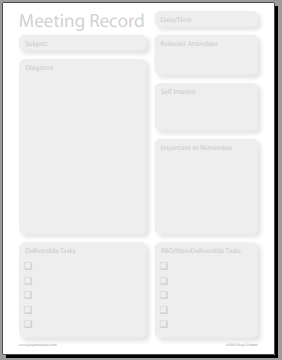I love and hate meetings. They can go one of two ways – productive or complete waste of time. As I get further into my career, I find myself as the organizer of a lot of meetings. In fact, I’m in meetings about 50% of my work week. I get a lot done. How is that possible? Here’s my list for the successful meeting:
- Know your limits. Go into meetings ready to defend what you can and cannot do. This doesn’t mean closed minded and inflexible. I’m talking about hard limits. Prepare yourself mentally to not give in to requests for things you can’t do. Prepare yourself with a good “I’ll get back to you” strategy.
- Bring the right tools. An Architect will bring a sketchpad and his colored pencils to a design meeting. An engineer will bring his calculator and blueprints to a engineering meeting. Make sure you have the tools you need for the agenda you are executing.
- Agree to an Agenda. Even if that agenda is to meet and figure out the agenda as you go. Having no agenda leads to all sorts of mayhem. Having one gives purpose.
- Take Notes. Going to a meeting without a way to take notes communicates to others in the meeting that it’s not important to you. Even if you never look at the notes again, it will help you remember what was discussed and what you may be responsible for down the road.
- Differentiate between Deliverable tasks and R&D tasks. They are two different things. It’s dangerous to track them together.
- Keep track of things that are interesting to you. Even if it’s not relevant to a task.
- Track who was at your meetings. Sometimes it’s helpful later on to ask someone if they remembered things the same way you did.
Over the years, I’ve played with many electronic and plain paper methods for capturing meeting information. Most of the tools out there lack the ability to keep up with the meetings I attend or organize – they are fast paced and crunched for time. The most amount of knowledge transfer and decision making must be completed in the shortest amount of time. As such, having a format that’s generic yet flexible is really the key to capturing the best and most relevant information.
To address this issue, I have created the Greg Moore system of meeting records – free for the taking. It’s not a silver bullet for every meeting type, but for most working, design or project management meeting – it tends to fit the bill nicely.

Download the Greg Moore Meeting Record System
Here’s why it works:
- The fields presented are merely a suggestion – they are screened back enough so that you don’t have to use every detail of the format.
- Doodles and diagrams are important – particularly in design or workflow discussions. Lots of space is required typically.
- Deliverable vs. Non-Deliverable tasks are always best as separate lists.
- If you run out of space on the page, flip it over and keep going.
- Self Interest: In every meeting, you are likely to hear things that are interesting to you, but not relevant to the immediate discussion.
- Important to Remember: Not everything that’s important is an action item. Tracking these as their own separate section can help keep your record useful later on.
What do you think? Leave your thoughts in the comments.
Leave a Reply